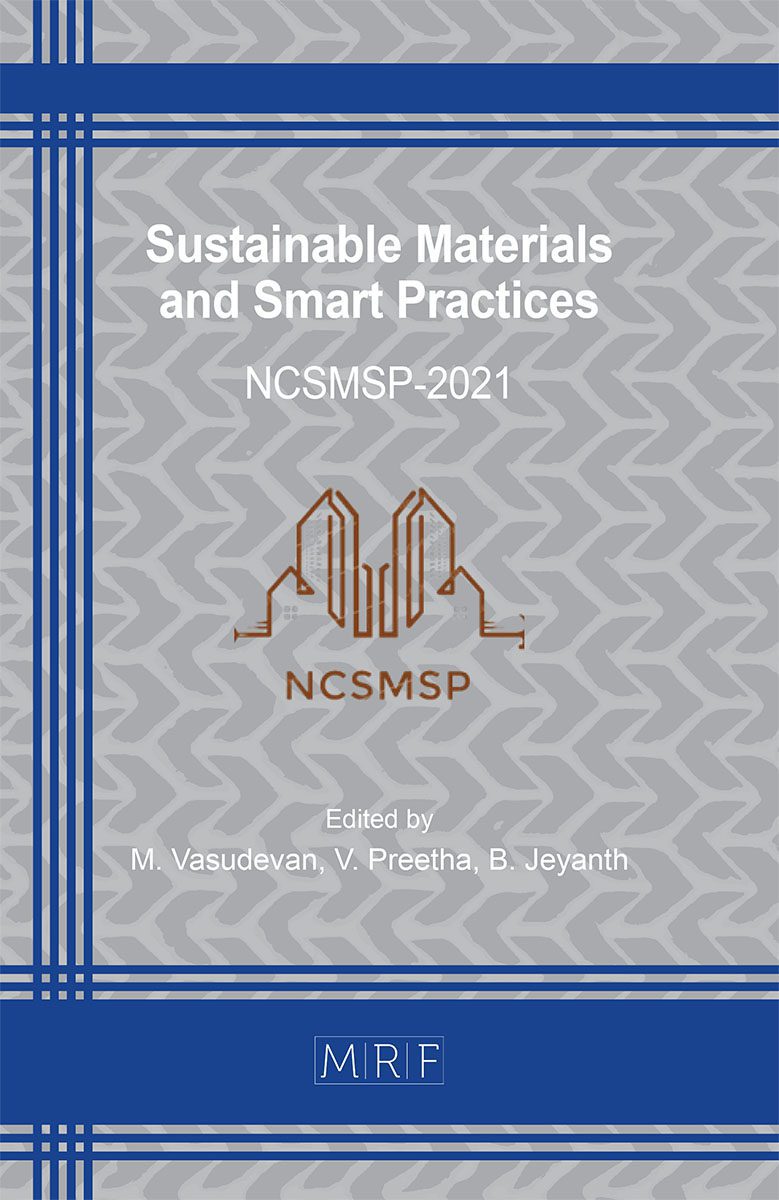Experimental Investigation on Effects of Bendable Composites on Ductility
S. Durgadevi, U.V. Krishnan, S. Vetrivel, M. Vijay
download PDFAbstract. The challenge in the structural characterization on ductile behaviour of bendable composite is to enhance the structural safety under severe loading. This paper emphasis on inclusion of a high dosage of fly ash (class F) with fly ash to cement (FA/C) in the ratio of 1.6 and an optimum amount of 2% of Polyvinyl Alcohol (PVA) fibres on the ductile behaviour of reinforced and unreinforced Bendable Composite. The absence of Coarse aggregates in this Bendable Composite reduces the crack width which increases the tensile strain capacity of Bendable Composites. The ductile behaviour of this Bendable Composite gives a high-end property in earthquake resistance applications when compared to conventional concrete.
Keywords
Bendable Composite, Fly Ash, Polyvinyl Alcohol Fibres (PVA), Ductile
Published online , 8 pages
Copyright © 2022 by the author(s)
Published under license by Materials Research Forum LLC., Millersville PA, USA
Citation: S. Durgadevi, U.V. Krishnan, S. Vetrivel, M. Vijay, Experimental Investigation on Effects of Bendable Composites on Ductility, Materials Research Proceedings, Vol. 23, pp 362-369, 2022
DOI: https://doi.org/10.21741/9781644901953-41
The article was published as article 41 of the book Sustainable Materials and Smart Practices
![]() Content from this work may be used under the terms of the Creative Commons Attribution 3.0 licence. Any further distribution of this work must maintain attribution to the author(s) and the title of the work, journal citation and DOI.
Content from this work may be used under the terms of the Creative Commons Attribution 3.0 licence. Any further distribution of this work must maintain attribution to the author(s) and the title of the work, journal citation and DOI.
References
[1] Carl Redon (2001), ‘Measuring and modifying interface properties of PVA fibres in ECC matrix’ Journal of materials in civil engineering, vol. 13, no. 6, pp.399-406. https://doi.org/10.1061/(ASCE)0899-1561(2001)13:6(399)
[2] Dhawale AW, Joshi VP (2013) ‘Engineered cementitious composites for structural applications’ International journal of application, vol.2, no.4, pp.198-205.
[3] Dong Bingqing; Pan Jinlong; Lu Cong, “Flexural behavior of steel reinforced engineered cementitious composite beams”, Journal of Southeast University, Volumn: 35 Issue: 2019 1 Page: 72-82
[4] Fukuyama, H., Matsuzaki, Y., Nakano, K. and Sato, Y. (1999), “Structural Performance of Beam Elements with PVA-ECC”, Proceedings of High Performance Fiber Reinforced Cement Composites 3 (HPFRCC 3), Ed. H.W. Reinhardt and A. Naaman, RILEM Publications S.A.R.L., PRO 6, pp 531-541.
[5] Hakan Nuri Atahan, (2013) ‘Behaviour of PVA fibre – reinforced cementitious composites under static and impact flexural effects’ Journal of materials in civil engineering, vol.25, no.10, pp.1438-1445. https://doi.org/10.1061/(ASCE)MT.1943-5533.0000691
[6] JIANG Shiyong, TAO Shuai,YAO Weilai,WU Shijuan, CAI Tao (2017), “Mechanical Performance and Size Effect of Engineered Cementitious Composite (ECC) Subjected to Uniaxial Compression, Materials Reports, Vol. 31 Issue (24): 161-168.
[7] Li, V.C. (1993), “From Micromechanics to Structural Engineering – The Design of Cementitious Composites for Civil Engineering Applications”, Structural Engineering and Earthquake engineering, Vol. 10, No.2, Japan Society of Civil Engineers, pp 37-48 https://doi.org/10.2208/jscej.1993.471_1
[8] Liang Li, Hongwei Wang, Jun Wu, Shutao Li and Wenjie Wu (2021) “Experimental Investigation on Dynamic Tensile Behaviors of Engineered Cementitious Composites Reinforced with Steel Grid and Fibers” Materials (Basel), Nov; 14(22): 7042. https://doi.org/10.3390/ma14227042
[9] Mohamed Maalej (2005) ‘Behaviour of Hybrid-Fibre engineered cementitious composites subjected to dynamic tensile loading and projectile impact’ Journal of materials in civil engineering, vol.17, no.2, pp.143-152. https://doi.org/10.1061/(ASCE)0899-1561(2005)17:2(143)
[10] Mustafa Sahmaran, (2011) ‘Effect of fly ash on microstructural damage and residual properties of engineered cementitious composites exposed to high temperatures’ Journal of materials in civil engineering, vol.23, no.12, pp.1735-1745. https://doi.org/10.1061/(ASCE)MT.1943-5533.0000335
[11] Peerapong Suthiwarapirak, (2004) ‘Multiple cracking and fibre bridging characteristics of engineered cementitious composites under fatigue flexure’ Journal of materials in civil engineering, vol.16, no.5, pp.433-443. https://doi.org/10.1061/(ASCE)0899-1561(2004)16:5(433)
[12] Shuxin Wang, Victor C Li (2007) ‘Engineered cementitious composites with High-Volume Fly ash’ ACI journal, vol.104, no.3, pp.233-241. https://doi.org/10.14359/18668
[13] Suleyman Bahadir Keskin, (2013) ‘Effect of pre-soaked expanded perlite aggregate on the dimensional stability and mechanical properties of engineered cementitious composites’ Journal of materials in civil engineering, vol.25, no.6, pp.763-771. https://doi.org/10.1061/(ASCE)MT.1943-5533.0000553
[14] Rathod JD, Patodi SC (2009) ‘ Effect of cement sand ratio and fibre orientation on tensile characteristics of ECC’ Indian Concrete Institute, vol.10, no.1, pp.17-23
[15] IS 1893 (Part I), 2002, Indian Standard Criteria for Earthquake Resistant Design of Structures (5th Revision).































